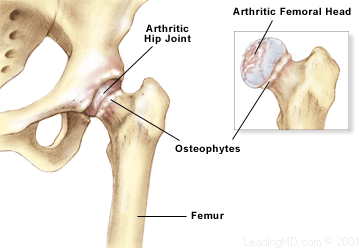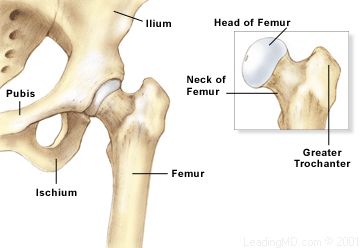 Hip
arthritis is a degenerative
condition that affects the hip joint, and often leads to a significant impairment
in the quality of life. The ability to walk, work and live pain free
can be adversely affected. Approximately 43 million Americans suffer
from arthritis and many of them are affected in the hip joint. In
general, the treatment of hip arthritis involves activity modification,
exercises, and treatment with anti-inflammatory medications. The use
of assist devices such as canes, crutches or walkers can also be helpful.
Occasionally surgical reconstruction such as total hip replacement
is necessary.
Hip
arthritis is a degenerative
condition that affects the hip joint, and often leads to a significant impairment
in the quality of life. The ability to walk, work and live pain free
can be adversely affected. Approximately 43 million Americans suffer
from arthritis and many of them are affected in the hip joint. In
general, the treatment of hip arthritis involves activity modification,
exercises, and treatment with anti-inflammatory medications. The use
of assist devices such as canes, crutches or walkers can also be helpful.
Occasionally surgical reconstruction such as total hip replacement
is necessary.
 What
is the hip joint and what does it do?
What
is the hip joint and what does it do?
The hip joint is a ball and socket joint.
The acetabulum, or socket, is formed by three areas
of the pelvic structure: the ilium, the ischium,
and the pubis. The femoral head is the "ball", which
is located on the upper end of the femur. There is
a high degree of fit and stability within this ball and socket joint.
It is stabilized by strong ligaments in the front of the hip which
prevent dislocation. Both the femoral head and the acetabulum are
covered with a layer of cartilage which provides shock absorption
and load distribution within the hip. This cartilage is also a source
of nutrition for the joint. Numerous muscles play an important role
in the stability of the hip, one of which is the gluteus medius.
This is a deep muscle within the buttock, and its proper function
is important in normal walking.
Function
Approximately 3 times the body weight is distributed through the hip with
routine activities due to the muscle pull and joint forces that occur.
Any degenerative condition within the hip will alter biomechanical relationships
and can cause limping, leg length inequality and disability. The stability
of the hip joint is maintained by the precise fit of the femoral head
within the acetabulum. The hip allows rotation in many planes. These include:
flexion/extension (used most commonly in sitting), internal
and external rotation (used with twisting activities), and abduction
and adduction (inward and outward motion of the hip in a scissoring
action).
What is hip arthritis?
Hip arthritis is any condition that leads to degeneration of the hip joint
and its cartilage surfaces. Some of these conditions are osteoarthritis,
rheumatoid arthritis, avascular necrosis and congenital
dysplasia (dislocation) of the hip. Fractures and other injuries
to the hip joint can also lead to hip degeneration.
Osteoarthritis is a degenerative condition that may affect
many joints throughout the body. It causes changes in the mechanical structure
of the cartilage, which lead to its breakdown. Over time complete loss
of the articular cartilage can occur. Changes in the underlying bone and
loss of cartilage can result in joint space narrowing, peripheral
osteophytes (bone spurs), loss of motion, pain and disability.
Rheumatoid arthritis is an inflammatory condition that affects
the lining of all joints in the body. It causes an inflammatory response
in the joint lining which destroys the articular cartilage and surrounding
tissues.
Osteonecrosis or avascular necrosis is a condition
in which the bone within the femoral head dies. This eventually leads
to the collapse of large segments of the bone supporting the cartilage
of the hip joint. It ultimately causes the destruction of the hip. The
main causes of osteonecrosis include:
-
injury such as femoral head fracture
or hip dislocation.
-
high
dose corticosteroid employed in the treatment of lupus , asthma, and
spinal cord injury.
-
heavy alcohol abuse.
The
final common pathway of hip arthritis is loss of the fit between the
femoral head and the acetabulum. This results in thinning or complete
loss of the cartilage, limitation of joint motion, shortening of the leg
and continual pain and disability.

© 2016 by LeadingMD.com All rights reserved
Disclaimer







 Hip
arthritis is a degenerative
condition that affects the hip joint, and often leads to a significant impairment
in the quality of life. The ability to walk, work and live pain free
can be adversely affected. Approximately 43 million Americans suffer
from arthritis and many of them are affected in the hip joint. In
general, the treatment of hip arthritis involves activity modification,
exercises, and treatment with anti-inflammatory medications. The use
of assist devices such as canes, crutches or walkers can also be helpful.
Occasionally surgical reconstruction such as total hip replacement
is necessary.
Hip
arthritis is a degenerative
condition that affects the hip joint, and often leads to a significant impairment
in the quality of life. The ability to walk, work and live pain free
can be adversely affected. Approximately 43 million Americans suffer
from arthritis and many of them are affected in the hip joint. In
general, the treatment of hip arthritis involves activity modification,
exercises, and treatment with anti-inflammatory medications. The use
of assist devices such as canes, crutches or walkers can also be helpful.
Occasionally surgical reconstruction such as total hip replacement
is necessary. What
is the hip joint and what does it do?
What
is the hip joint and what does it do?